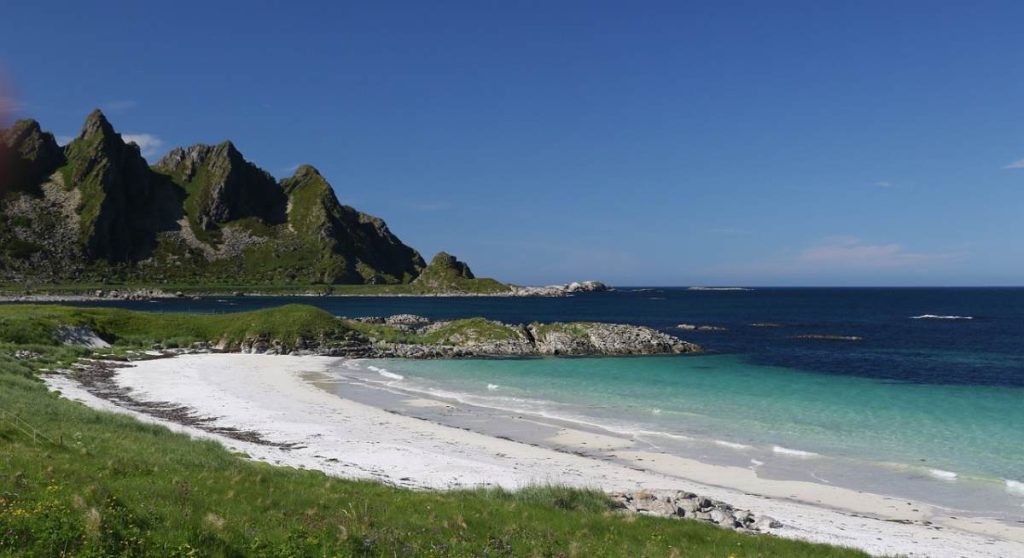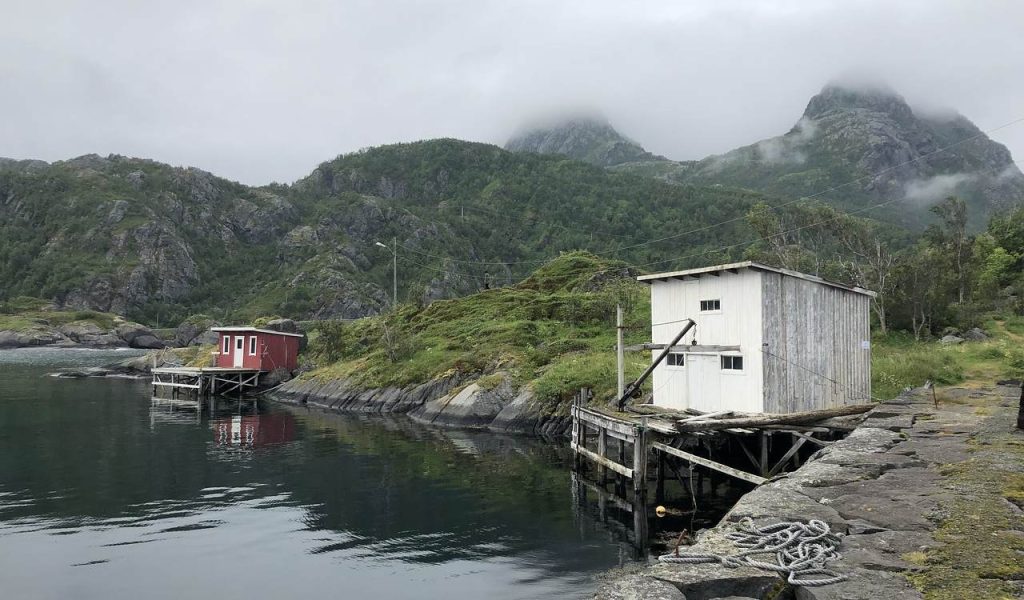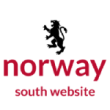Beyond the Arctic Circle, there are beautiful islands, each with its own identity, different from each other, but all offering travelers stunning scenery of jagged mountains, deep fjords and fishing villages. These cities can be visited all year round, where in summer the sun never sets between the end of May and the end of July and in winter, where darkness is total between the end of November and the end of January.

SUMPTUOUS LANDSCAPES OF POSTCARDS
When we talk about the islands of Northern Norway, we immediately think of the archipelago of the Lofoten Islands with its pretty fishing villages, its huts on stilts called rorbuer in Norwegian, its mountains plunging steeply into the sea, its sandy beaches, its turquoise waters and its many visitors.
A beach and colorful houses in winter in Lofoten Islands, Norway
A beach and colorful houses in winter in Lofoten Islands, Norway
But we often forget that a little further north, we have the island of Senja, still unknown to the general public, protected until now from mass tourism, a real little paradise for nature lovers and quietness. When you discover the island of Senja, you fall in love with it.
Senja Island is the second largest island in Norway after Hinnøya, and is nicknamed Norway in miniature because it has all the landscapes that Norway has to offer: jagged mountains, fjords, valleys, fishing villages, national parks. The island of Senja has one of the national tourist roads of Norway which offers to the travelers, the time of 102 km through a sinuous and narrow road from Botnhamn to Gryllefjord, in the north, sumptuous landscapes of postcards with steep mountains plunging into the crystalline and frozen waters of the ocean with sight on the small villages of fishermen offering a true spectacle of which one does not get tired. In Bergsbotn, we will find a platform from where from the heights, we will be able to have a panoramic view on the fjord with its enchanting landscapes between mountains and fjords. Through its auto-tours, Nord Espaces has been proposing for more than 20 years, a stop in Senja through its program “All the North only the North”.

Then, from Gryllefjord, we take a ferry to Andenes (only in summer), the northern point of the Vesterålen Islands that often, we skip in favor of the Lofoten Islands but which do not lack charm. My first trip to the northern islands of Norway was to the Vesterålen Islands, 17 years ago. The purpose of this trip was to observe whales, which left me with a lot of memories, but this can be the subject of a future article. As the Lofoten Islands are becoming more and more popular, a trip to the neighboring Vesterålen Islands will not be a cheap trip, the Vesterålen Islands will offer you the same experiences with just a little less crowd.
The Vesterålen are for me wilder than the Lofoten, with as beautiful beaches as in the Caribbean with just a little bit cooler water than in the Caribbean or in Asia. One of my favorites was the discovery of the splendid beach of Bleik at the doors of Andenes which will remain engraved forever in my memory. It is hard to believe that we are north of the Arctic Circle with its white sand beach and turquoise water. We stopped there for a few hours and took a walk in a peaceful setting and especially without anyone in the vicinity. We also hiked in the smallest national park of the country which covers an area of 51.2 km2 and whose highest point is the Moysalen with its 1262 meters of altitude.
THE AURORA BOREALIS
The northern islands of Norway offer perfect conditions for observing the aurora borealis in winter. You can also ski, do Nordic activities, watch whales and visit the Ondoya Space Centre where you can take a virtual trip into space and discover where the northern lights come from and see their effects on our planet. You will launch probes and see what daily life is like in a space center.
In Senja, in the Vesterålen Islands, or in the Lofoten Islands, it is possible to observe the northern lights on clear days in places with low light pollution. You can enjoy this experience from the end of August. The northern islands of Norway are very popular with professional photographers to immortalize these bluish, green lights but it is a random phenomenon, if the weather is overcast, it will unfortunately be impossible to observe them.
OBSERVATION OF THE MARINE FAUNA AND PUFFINS
At 68 degrees north, you will find the Vesterålen Islands, the only place where whale watching is possible all year round from the small fishing village of Stø in summer and all year round from Andenes. In winter, whale watching is also possible in Senja and also further north in Tromsø. Sperm whales, humpback whales, killer whales, Minke whales and pilot whales can all be seen. Wildlife lovers can observe the largest puffin colony in northern Norway, 5 km from Stø. In Vesterålen, there are about a hundred islands that form many reefs and thanks to the warm currents, the sea is rich in food and attracts a rather exceptional fauna.
A PRESENT CULTURE
The islands are not only about nature and wildlife observation, but also about an identity, a culture that is very present.
In the Lofoten Islands, we visited the impressive Viking Museum in the village of Borg on the island of Vestvågøy. More than 1000 years ago, one of the most powerful Viking chiefs in northern Norway ruled in Borg. The largest Viking building was located here. The house of the Viking chieftain has been rebuilt to its original size (83 meters). As soon as you walk through the door, you can smell the fire and it’s easy to get into the Viking atmosphere 1000 years ago. We will appreciate the exhibition on the history and the Viking mythology. During my visit, a meal was served to us and we had the opportunity to taste the Viking food, it was a real invitation to travel 1000 years ago. Every beginning of August is the Viking festival with many activities proposed but it is highly recommended to book in advance.
Fishing and the sea are an integral part of the local identity of the islands of northern Norway. We have been fishing here for ten centuries. The winter cod fishing starts in January and ends in April. We find mainly cod, cod, hake, haddock, redfish, halibut. When walking in winter in the islands, you can have the chance to see the cod drying on wooden poles to turn them into stockfish.
In Stokmarknes, there is a museum of the coastal express that traces the history of this maritime service that has played a major role in the everyday life of Norwegians. Further north, on the island of Andøy, in Andenes, is the Andøy museum where you can discover that one of the most famous polar hunters comes from the island of Andy. In this museum you can see an exhibition about the life of the hunters and learn more about the geology of the island. Also, you can go up to the Andenes lighthouse built in 1859 and which is one of the highest in the country measuring 40 meters high. Inside the lighthouse there is an interesting exhibition about the port and the Andenes lighthouse.
In Senja, we will discover that the island has a long historical tradition of fishing, Sami, agriculture and industry. There is a very interesting Sami Museum in Kaperdalen that can be visited during a visit to the island.
A PARADISE FOR OUTDOOR ACTIVITIES
For lovers of sports activities, the islands of northern Norway are made to indulge in various outdoor sports. In the Lofoten Islands, you can go horseback riding, biking, surfing in Unstad, kayaking and hiking. In the Vesterålen Islands, the most experienced can take the Queen’s Trail, which is quite steep but offers a splendid panorama of the coast and mountains between the villages of Nyksund and Stø. If you have time, discovering the islands by bike can also be a great experience, allowing you to do sports in a splendid setting with a view of the sea and the mountains. Enjoying the islands by sea is also a great experience.
